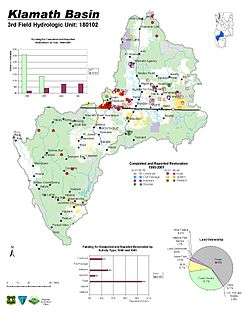Klamath Basin Restoration Agreement
The Klamath Basin Restoration Agreement (KBRA) is an American multi-party legal agreement determining river usage and water rights involving the Klamath River and Klamath Basin in the states of California and Oregon. Discussion of the KBRA began in 2005 and was ultimately signed into law in February 2010.
Parties to the agreement included the state of California, the state of Oregon, the Karuk Tribe, the Klamath Tribes, the Yurok Tribe, Del Norte County, California, Humboldt County, California, Klamath County, Oregon, Siskiyou County, California; 26 private individuals, companies, and local irrigation districts; and seven NGOs including California Trout and Trout Unlimited.[1]
History
Background
The idea behind the document originally stemmed from the 2001 irrigation water shutoff to Klamath Project farmers, when water was withheld from the irrigators in favor of the threatened coho salmon and the endangered Lost River Sucker.[2] Downstream populations of coho salmon are within the Southern Oregon/Northern California Evolutionary Significant Unit and are listed as threatened (2011).[3]
That summer, a symbolic Bucket Brigade was held, where nearly 20,000 people passed 50 buckets of water, one for each state, from Upper Klamath Lake to the A canal that supplies water to the Klamath Project.[4]
Development
Talks commenced in 2005; a draft was proposed by 2009.
The Klamath Basin Restoration Agreement (KBRA) is a document that aims to:
- help restore Riparian Zones along much of the rivers in the Klamath Basin
- remove 4 Hydroelectric dams on the Klamath River with the goal of salmon restoration
- provides irrigation water assurances for Klamath Basin farmers
- provides the Klamath Tribes with the 90,000 acre Mazama Tree Farm
Signing
The final document was signed on February 18, 2010 in Salem, Oregon. Among the more notable signatories to the agreement were the Governor of California, Arnold Schwarzenegger, the Governor of Oregon, Ted Kulongoski, and the Chairman of the Klamath Tribes, Joseph Kirk.
Unfortunately, Congress failed to pass legislation that would implement the KBRA by the January 1, 2016 deadline.[5] A new agreement, the Klamath Hydroelectric Settlement Agreement (KHSA) was signed on April 6, 2016 which plans to remove four hydroelectric dams (the Copco 1, Copco 2, J.C. Boyle, and Iron Gate) by 2020.[6]
Footnotes
- ↑ "Klamath Basin Restoration Agreement" (PDF). Klamath Restoration. Retrieved 8 April 2016.
- ↑ "Water Conflicts and Crises," The Oregon Story, Oregon Public Broadcasting.
- ↑ "Southern Oregon/Northern California Coast Recovery Domain 5-Year Review: Summary and Evaluation of Southern Oregon/Northern California Coast Coho Salmon ESU" (PDF). National Oceanic and Atmospheric Administrations. 2011. Retrieved 2013-12-03.
- ↑ "Klamath Falls bucket brigade protests water shutoff." Heartland, July 1, 2001.
- ↑ "Uncharted Waters". The North Coast Journal Weekly. Retrieved 2016-05-08.
- ↑ "Klamath dam deal only the start, officials say". www.times-standard.com. Retrieved 2016-05-08.
External links
- The KBRA Document as signed on February 18, 2010
- Klamath Restoration website
- The Klamath Hydroelectric Settlement Agreement
